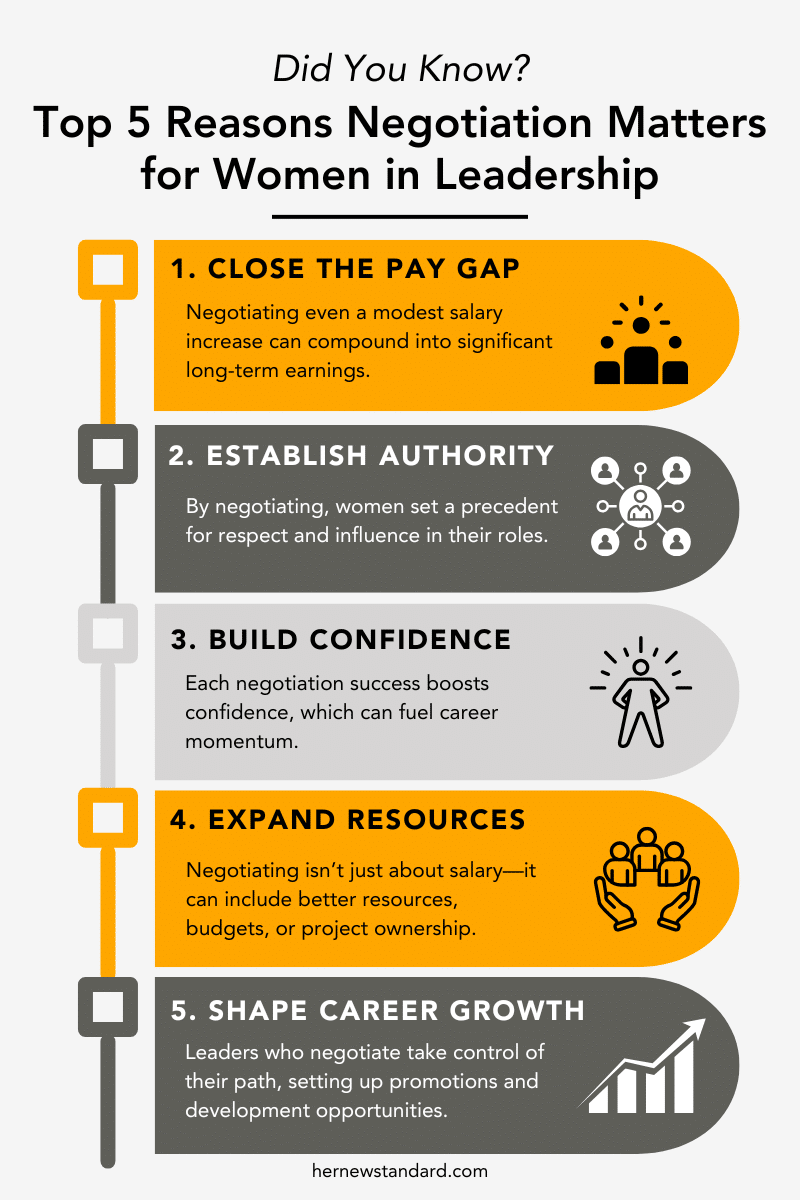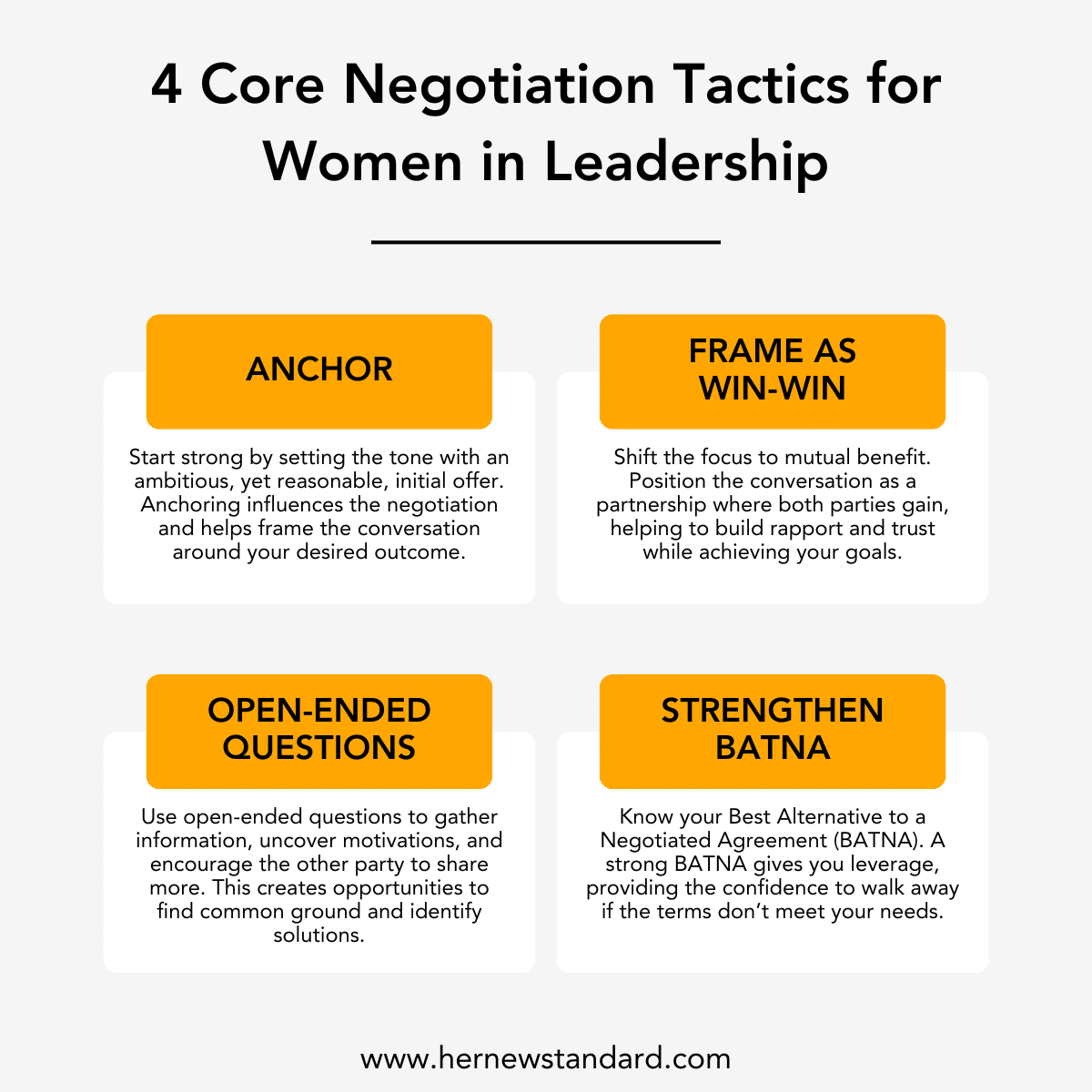In our work with women in leadership, we see a common struggle: negotiation doesn’t always come easily, even for accomplished professionals. While many learn to negotiate around pay and promotions, the true power of negotiation goes far beyond individual wins. It’s a skill that opens doors, commands respect, and lays the foundation for enduring success.
Yet, mastering negotiation has immense value. When women develop this skill, they accomplish more than individual career progression. They empower their teams, set new standards, and help reshape what’s possible for future generations of leaders. Without it, barriers remain unchallenged, limiting both individual growth and the broader impact women can have on their organizations.
What is Negotiation and Why is it Different for Women Leaders?
Negotiation is simply the process of reaching a mutually beneficial agreement between two or more parties.
However, many women face unique challenges in negotiation. Societal and cultural barriers often discourage them from negotiating for what they deserve. As a result, women are less likely to engage in negotiations and can miss key opportunities for growth. This reluctance can contribute to ongoing financial and leadership gaps. Failing to negotiate not only limits earnings but also undermines confidence, influence, and career advancement.
By mastering negotiation, women have the power to elevate their careers, shape workplace dynamics, and inspire a ripple effect that enhances the entire organization.
4 Effective Negotiation Tactics for Women in Leadership
Mastering these four negotiation tactics is essential to help women leaders approach conversations strategically and achieve successful outcomes:
1. Set the Stage with a Strong Anchor
Start strong by setting the tone with an ambitious, yet reasonable, initial offer. Anchoring influences the negotiation and helps frame the conversation around your desired outcome.
2. Reframe the Conversation as a Win-Win Opportunity
Shift the focus to mutual benefit. Position the conversation as a partnership where both parties gain, helping to build rapport and trust while achieving your goals.
3. Gain Insights Through Open-Ended Questions
Use open-ended questions to gather information, uncover motivations, and encourage the other party to share more. This creates opportunities to find common ground and identify solutions.
4. Come Prepared With Your BATNA
Know your Best Alternative to a Negotiated Agreement (BATNA). A strong BATNA gives you leverage, providing the confidence to walk away if the terms don’t meet your needs.
Strengthening Negotiation Skills – A Case Study in Pharma
Let’s see how these negotiation strategies could play out in action. Consider Sarah, a director at a large pharmaceutical company, who sees an opportunity to improve her team’s effectiveness through a strategic restructure. Maybe you’ll see some of your own experiences in hers.
For over a year, Sarah had led a high-performing team, but she recognized room for improvement in efficiency and morale, particularly in how cross-functional teams collaborated. She wanted to propose a new team structure to senior management, knowing this change could drive better outcomes for product development. Still, she was concerned that her request might be perceived as disruptive or a critique of past decisions. Instead of holding back, Sarah leaned into four core negotiation techniques to secure buy-in.
1. Anchor: Starting with Data-Driven Insights
Sarah built her case on key performance metrics from past product launches, team feedback, and examples of successful team structures in the pharmaceutical industry. By starting her pitch with data, she anchored the conversation on facts, showcasing how restructuring would improve cross-functional collaboration and speed to market for new products.
2. Frame as Win-Win: Aligning with Company Goals
Knowing that buy-in would depend on aligning with the company’s broader goals, Sarah reframed her proposal as a win for the entire organization. Instead of focusing solely on team issues, she emphasized how the restructure would streamline operations, improve the speed of regulatory approvals, and enhance market readiness for new products. By positioning her case within the company’s long-term growth and innovation objectives, Sarah turned her request into a strategic alignment that resonated with leadership.
3. Ask Open-Ended Questions: Engaging in Dialogue
Sarah knew the importance of involving leadership in the conversation. She asked open-ended questions that encouraged collaboration, such as:
- “What impact do you think this restructure could have on team efficiency and project timelines?”
- “How can we ensure the proposed changes align with the company’s long-term goals for innovation?”
- “What would make this proposal more beneficial from a leadership perspective?”
These questions helped Sarah gain valuable insights from decision-makers while allowing them to feel part of the solution. It also gave Sarah the flexibility to adjust her approach based on their feedback.
4. Strengthen BATNA: Building a Strong Backup Plan
To bolster her confidence, Sarah prepared a backup plan—a Best Alternative to a Negotiated Agreement (BATNA)—which included smaller process changes she could implement independently. This gave her leverage to present her ideal proposal, knowing she had viable alternatives if it didn’t get full approval.
By applying anchoring, framing as a win-win, asking open-ended questions, and strengthening her BATNA, Sarah gained leadership’s approval, reinforcing her reputation as a strategic thinker while securing needed changes for her team.
For any leader, these tools can turn negotiation into a powerful way to drive both personal and organizational growth. What negotiation are you preparing for where these strategies might be useful? How could they help you shape the outcome you want?
What’s Your BATNA? Understanding Your Best Alternative to a Negotiated Agreement
Your BATNA represents the best course of action if the current negotiation doesn’t lead to a favorable outcome. Knowing your BATNA empowers you to negotiate from a position of strength.
Here’s what’s involved in clarifying your BATNA:
- Identify Your Alternatives: What will you do if this negotiation doesn’t work out? List potential alternatives.
- Evaluate Your Options: Rank these alternatives based on desirability and feasibility.
- Strengthen Your BATNA: What steps can you take now to improve your fallback options?
- Use Your BATNA in Negotiation: The stronger your BATNA, the more leverage you’ll have.
The Cost of Not Negotiating
For companies that want to foster and retain women leaders, understanding the consequences of not negotiating is crucial. The salary gap between men and women often starts at the negotiation table. According to the U.S. Census Bureau, women earn about 83 cents for every dollar earned by men. However, women who negotiate often close that gap considerably, with research showing that those who negotiate their salaries earn $1 million more over the course of their careers.
But the issue goes beyond salary. Women who don’t negotiate are often perceived as less assertive, a characteristic wrongly equated with leadership potential. This perception can hinder opportunities for promotion. A recent study revealed that for every 100 men promoted to managerial roles, only 81 women are promoted. This disparity contributes to the fact that only 8.2% of Fortune 500 CEOs are women.
The Bottom Line
Negotiation is a cornerstone of strong leadership. Women who learn to negotiate gain the confidence to step into higher roles, secure their financial futures, and make a more significant impact within their organizations. Companies that foster negotiation skills among their female leaders not only support gender diversity but also improve their bottom line.
If you’re a woman in leadership—or an organization seeking to support the women in your ranks—ignoring negotiation skills could be a costly mistake. Women who don’t negotiate risk falling behind, but those who do position themselves as powerful leaders capable of shaping not just their futures but the future of their companies as well.
Recommended Reading for Women on Negotiation
- “Women Don’t Ask” by Linda Babcock and Sara Laschever
A foundational book on negotiation strategies for women, Women Don’t Ask explores the reasons behind the hesitation many women feel in asking for what they deserve and offers tailored strategies to overcome these barriers and negotiate more effectively. - “Brave, Not Perfect: Fear Less, Fail More, and Live Bolder” by Reshma Saujani
Saujani’s book addresses societal pressures that hold women back from risk-taking and ambition. With strategies to overcome the fear of failure, it provides valuable tools for high-stakes negotiations, helping women build the courage to advocate for their worth.
Ready to empower the women in your organization to negotiate, influence, and lead with confidence?
Her New Standard’s women’s leadership programs provide hands-on development, tailored for high-impact results and growth at every career stage. Give your team the tools they need to drive both personal and organizational success.
Enjoyed this post? You might also like…






